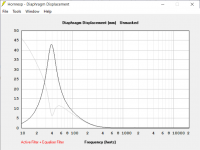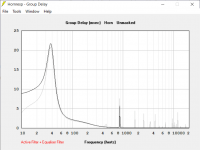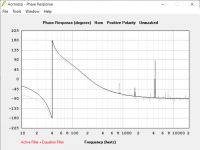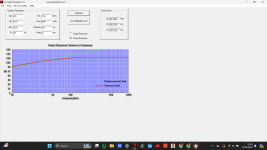I have no reason whatsoever to doubt this, but simply cannot get my head around phase response being identical in mechanical and electrical systems!... and if you have 2 different boxes each filtered to end up with the same final frequency response, they will end up with the same final phase/GD as well.
I have no reason whatsoever to doubt this, but simply cannot get my head around phase response being identical in mechanical and electrical systems!
Remember, the whole point of Thiele & Small's work was to use existing electrical circuit theory to describe loudspeakers, so it shouldn't be that much of a surprise
I've got to admit I don't have deep enough mathematical knowledge to explain it fully, but basically, for anything that has infinite impulse response, any system that causes a given frequency response has a fixed phase response, so whether that mechanism is physical (ie driver moving mass + suspension + box compliance etc) or electrical (EQ circuit) then end result is the same.
To an extent, we can model it in WinISD or similar.
Just set up 2 versions of a project with the same driver in 2 different sized sealed boxes, then apply a Linkwitz Transform to the smaller one to make it have the same FR as the bigger one - then check the Phase & GD.
Last edited:
Can we truly disregard energy storage in, for example, a ported (resonant) enclosure so simply?Just set up 2 versions of a project with the same driver in 2 different sized sealed boxes, then apply a Linkwitz Transform to the smaller one to make it have the same FR as the bigger one - then check the Phase & GD.
Can we truly disregard energy storage in, for example, a ported (resonant) enclosure so simply?
I'm afraid that's about the point where my lack of mathematical expertise stops me giving any credible answer, sorry.
FWIW, if you take a sealed box EQ'd flat down to a very low frequency and then apply a 4th order HPF, you'll get the same time-domain performance as a ported box.
From what I can tell, it's the sharp knee before the rolloff that gives ported boxes their time-domain issues.
Whether those issues are audible or not is another discussion entirely.
Chris
From what I can tell, it's the sharp knee before the rolloff that gives ported boxes their time-domain issues.
Whether those issues are audible or not is another discussion entirely.
Chris
Are there any real-world measurements of this? I have heard it stated on many occasions but never seen any supporting data.FWIW, if you take a sealed box EQ'd flat down to a very low frequency and then apply a 4th order HPF, you'll get the same time-domain performance as a ported box.
Chris,FWIW, if you take a sealed box EQ'd flat down to a very low frequency and then apply a 4th order HPF, you'll get the same time-domain performance as a ported box.
A sealed box does not have the same time-domain performance as a ported box.
The port output of a bass reflex (BR) box is in phase with the sound waves emanating from the front of the driver's cone, but lags behind the front radiation by one cycle at the box tuning frequency (Fb), hence BR designs are also known as "phase inversion" designs.
This is clearly evident in Josh Ricci's test of the SVS PB13, which can be operated sealed, or with a 15Hz or 20Hz Fb.
https://www.audioholics.com/subwoofer-reviews/svs-pb13/pb13-measurements
In the group delay chart, the blue line represents one cycle at the given frequency, 100ms at 10 Hz, 50ms at 20Hz, 10ms at 100Hz, the red 1.5 cycles of delay.
The green trace of the sealed is basically 1/2 wavelength all the way down to 10Hz.
Around the 15Hz (purple) or 20Hz (black) Fb, the ported delay goes just over the red 1.5 cycles curve, above 30Hz it matches the sealed response.
As you mentioned, whether those issues are audible or not is another discussion, but the issues are inherent in the phase-inversion that makes a BR cabinet perform as it does. Can't get something for nothing...
I certainly can hear (and feel) the huge SPL advantage around Fb compared to sealed, but can't hear the time domain difference over the typical decay times of LF program material or room modes.
Art
Put a big chunk of capacitance in series with the driver in a sealed box and get a few dB extra at low frequencies at same voltage drive level with no vent required  .
.
GD at low frequencies really isn't that big of an issue. Our hearing is not that good at low frequencies. Seriously. And the Qtc @ 1W is not going to be the Qtc @100W or 1kW anyway.
For PA use, especially high-power PA use, I'd consider reverse-mounting the drivers as previously suggested and extend the sides of the box around the baffle to protect the driver's motor structure.
GD at low frequencies really isn't that big of an issue. Our hearing is not that good at low frequencies. Seriously. And the Qtc @ 1W is not going to be the Qtc @100W or 1kW anyway.
For PA use, especially high-power PA use, I'd consider reverse-mounting the drivers as previously suggested and extend the sides of the box around the baffle to protect the driver's motor structure.
Chris,
A sealed box does not have the same time-domain performance as a ported box.
The port output of a bass reflex (BR) box is in phase with the sound waves emanating from the front of the driver's cone, but lags behind the front radiation by one cycle at the box tuning frequency (Fb), hence BR designs are also known as "phase inversion" designs.
This is clearly evident in Josh Ricci's test of the SVS PB13, which can be operated sealed, or with a 15Hz or 20Hz Fb.
https://www.audioholics.com/subwoofer-reviews/svs-pb13/pb13-measurements
In the group delay chart, the blue line represents one cycle at the given frequency, 100ms at 10 Hz, 50ms at 20Hz, 10ms at 100Hz, the red 1.5 cycles of delay.
The green trace of the sealed is basically 1/2 wavelength all the way down to 10Hz.
Around the 15Hz (purple) or 20Hz (black) Fb, the ported delay goes just over the red 1.5 cycles curve, above 30Hz it matches the sealed response.
As you mentioned, whether those issues are audible or not is another discussion, but the issues are inherent in the phase-inversion that makes a BR cabinet perform as it does. Can't get something for nothing...
Art,
My post said specifically a sealed box with additional processing. I've included some attachments to show what I mean.
I certainly can hear (and feel) the huge SPL advantage around Fb compared to sealed, but can't hear the time domain difference over the typical decay times of LF program material or room modes.
Art
Me too. I'd much rather these cabinets were ported, but I needed to replace my old subwoofers, had these drivers lying around, and needed something compact. The VLF capability is a bonus, but the limited output means that only works in smaller venues.
Put a big chunk of capacitance in series with the driver in a sealed box and get a few dB extra at low frequencies at same voltage drive level with no vent required.
GD at low frequencies really isn't that big of an issue. Our hearing is not that good at low frequencies. Seriously. And the Qtc @ 1W is not going to be the Qtc @100W or 1kW anyway.
For PA use, especially high-power PA use, I'd consider reverse-mounting the drivers as previously suggested and extend the sides of the box around the baffle to protect the driver's motor structure.
Brian,
The capacitor achieves this by reducing the impedance over a narrow frequency range, essentially pulling more current to achieve that LF boost. As Art said, can't have something for nothing. I did have a quick look on Hornresp, and found that when the response was somewhere near flat (approx 700uF in series), I was still losing a few dB above 60Hz, in exchange for +5dB at 40Hz. Finding ~700uF of capacitor which would stand a couple of hundred volts across it might be tricky.
I did think about putting the motors outwards, but that would have made the boxes at least 4" deeper, plus the extra internal volume that I'd need to find. Currently, the pole piece vent has a short tunnel (around 55mm long) to the outside world. It's not a perfect cooling solution, but I suspect it works better than ported subwoofers with long ports.
On the attached Hornresp screenshots, there are two very different subwoofers. They each use a Beyma 15P1200Nd. Grey is 100L ported tuned to 40Hz, black is 50L sealed with a single EQ filter (around 10dB boost at 39Hz) and a 2nd order highpass. I matched the frequency response curves as closely as I could in the time I had, and then checked the phase and group delay. Excursion is included as a minor point of interest.
Chris
Attachments
Yup - the "trick" here is that you don't need any more voltage out of the amp to get that extra 5dBThe capacitor achieves this by reducing the impedance over a narrow frequency range, essentially pulling more current to achieve that LF boost. As Art said, can't have something for nothing. I did have a quick look on Hornresp, and found that when the response was somewhere near flat (approx 700uF in series), I was still losing a few dB above 60Hz, in exchange for +5dB at 40Hz. Finding ~700uF of capacitor which would stand a couple of hundred volts across it might be tricky.
Parts Express have 100V 200uF and 500 uF capacitors. Might have to order 4 of each if your amp is sending a higher voltage to those drivers, which can end up being a bit on the expensive side (around $50) ...
So when mounting the subwoofer magnet outside the sealed box is reverse polarity required?
I’ve got 1000uf in series with my subs (HP in the high 20’s) and the difference was noticeably stronger/cleaner down bottom, i did have to slightly adjust phase/gd in the dsp afterwards as it seemed to have moved the transient timing a little between sub/mains. But as of the last 6 months it is permanent (sometimes these tweeks wear on you after awhile, but this one disappeared) although i may try with some better caps (used cheap M.D.L. from Madisound)
I’ve got 1000uf in series with my subs (HP in the high 20’s) and the difference was noticeably stronger/cleaner down bottom, i did have to slightly adjust phase/gd in the dsp afterwards as it seemed to have moved the transient timing a little between sub/mains. But as of the last 6 months it is permanent (sometimes these tweeks wear on you after awhile, but this one disappeared) although i may try with some better caps (used cheap M.D.L. from Madisound)
Last edited:
@chris661, I am very happy to have found this thread.
Currently, I run four of these elements in my home theater, housed in 150-liter sealed boxes.
I have been operating them without a Low Pass Filter and using Dirac Room correction to equalize them to flat.
I can boost the low end with Dirac, but I am wondering if it would be more beneficial to use an LPF like you have.
I feel that I am missing some infra-bass by running them this way, so I am considering adding either a Linkwitz Transform or an LPF.
Which one would be preferable? Is there any point when using Dirac to equalize these anyway?
I am thinking to test your 18hz@ 12db/octave. (is this Butterworth or Linkwitz Riley slope?)
Here you can see the response from my room.

Currently, I run four of these elements in my home theater, housed in 150-liter sealed boxes.
I have been operating them without a Low Pass Filter and using Dirac Room correction to equalize them to flat.
I can boost the low end with Dirac, but I am wondering if it would be more beneficial to use an LPF like you have.
I feel that I am missing some infra-bass by running them this way, so I am considering adding either a Linkwitz Transform or an LPF.
Which one would be preferable? Is there any point when using Dirac to equalize these anyway?
I am thinking to test your 18hz@ 12db/octave. (is this Butterworth or Linkwitz Riley slope?)
Here you can see the response from my room.
Last edited:
The lowpass filters I used were just a convenient way of getting the frequency response to a useful shape: flat from ~20Hz-70Hz, rolling off above that.
In your case, I'd recommend EQ to boost the response below 30Hz. I expect you have plenty of headroom, and these drivers can take a lot of power!
Chris
In your case, I'd recommend EQ to boost the response below 30Hz. I expect you have plenty of headroom, and these drivers can take a lot of power!
Chris
I've just built a dual 18XL1800 enclosure and it's integrated in my living room as the fourth subwoofer. I'm very pleased with their performance and I'm planning to replace my 4x 15" Visaton with another 4x Faital Pro 18XL1800. If I'd have to start from scratch I'd skip the 21" and choose this woofer for all my subs.
Here the combined response in my room.

Here the combined response in my room.

Glad to see more DIY guys catching on....Yep, a bigger sealed box would mean less power needed to reach Xmax. However, for portable PA use, I had to balance power input vs size. The amplifiers I'm using are very efficient, and have enough output to ensure the driver's maximum potential is reached in these compact cabinets.
For home HiFi use, I think these drivers in large sealed boxes would be excellent.
Chris
This has been the case for 15 to 20 years, god knows I have spent hours explaining this (and the related time distortion advantages) on this forum for ever!
There are a lot of good 12, 15 and 18 inch Pro bass drivers which will all work superbly in 50 to 100 liter sealed boxes... Just Eq and power with decent ICE Power / Hypex / type amps to suit your room and ears... So easy, no black art or 10 editions of "Loudspeaker Design Cookbooks" required.
These drivers work very well in sealed cases for home use. I have four of these in a 150-litre case, but I don’t remember the calculations used to reach Xmax .This driver has plenty of Xmax for a professional driver and doesn’t make strange noises even when worked hard. It can also move a significant amount of air.
That said, running them without either an Equalizer (EQ) or Low Pass Filter (LPF) will result in the bottom octave lacking authority. I am trying to optimize this and figure out a smart way to do this in a home environment.
Using EQ with MiniDSP is not straightforward, as it easily ‘clips’ the inputs on the MiniDSP if you apply EQ or listen at louder levels.
Option 1: I have tried the Linkwitz Transform, which boosts the low end nicely, but you run into the clipping issue.
Option 2: Using an LPF to flatten the response, as Chris661 has done.
Since I am using Dirac, which will take care of the EQing, I feel that limiting the bandwidth could yield better results with Dirac.
I will give that a try and see if it sounds better than running them without any EQ at all.
That said, running them without either an Equalizer (EQ) or Low Pass Filter (LPF) will result in the bottom octave lacking authority. I am trying to optimize this and figure out a smart way to do this in a home environment.
Using EQ with MiniDSP is not straightforward, as it easily ‘clips’ the inputs on the MiniDSP if you apply EQ or listen at louder levels.
Option 1: I have tried the Linkwitz Transform, which boosts the low end nicely, but you run into the clipping issue.
Option 2: Using an LPF to flatten the response, as Chris661 has done.
Since I am using Dirac, which will take care of the EQing, I feel that limiting the bandwidth could yield better results with Dirac.
I will give that a try and see if it sounds better than running them without any EQ at all.
Make their sealed boxes ported. A friend of mine happily uses 6 of them, each in a 200-liter bassreflex box, tuned around low 20s. He says it hard to breathe when he turns up the volume.That said, running them without either an Equalizer (EQ) or Low Pass Filter (LPF) will result in the bottom octave lacking authority. I am trying to optimize this and figure out a smart way to do this in a home environment.
Last edited:
This might be of help for PA / Live sound - A Sim of a Beyma 18 QLEX 1600 Fe- At Max AES continuous power = 113db @ 30Hz… Twin subs = 116dB plus 4 dB room/corner gain = 120 dB @ 30 Hz… = Structural damage to body and building... And all of this performance in a small 50 liter sealed box... I can easily put 10 of them in my SUV!Man, I'm now totally into thinking about new sealed subs. The rabbit hole has got a firm hold of my foot.
I have a question about cabinet size vs processing, vs phase issues. (Or group delay, or whatever the correct term would be.)
Obviously, sealed subs need quite a bit of boost using a low shelf filter. And filters have phase issues. (Something I don't have a good grasp on, but I know this is a thing.) Plus we want the subs to be as phase-aligned with the tops as possible.
So would it be correct to assume that one benefit of a larger enclosure is that there is more acoustical LF extension? In other words, you need less gain on the low-shelf boost, and hence less phase anomalies?
Would it also mean that a processor with FIR filters would be preferable?
There are lots of good PA power amps with built in DSP which enable you to tune and balance the sound easily to a very high sound quality standard.
The ability to limit driver excursion and / or power input is usually a standard feature on this types of loudspeaker management gear.
A domestic use case would be around 500 watts AES (the drivers are rated at 1,500 watts continuous and 3KW peak power handling) and only 8mm cone travel... The drivers are AES rated with a plus/minus 13 mm Xmax and 30 mm before damage.
So running a single sub at one third of max power holds 108 dB continuous SPL ... A pair in with around 4dB room gain will hold 115dB SPL at 30Hz... DIY build cost around $750 using high quality 24mm Birch Ply and a nice spray paint finish...This makes a mockery of the snake oil rip off "High END Audiophile" sub woofers at $5,000 to $10,000 each!
Attachments
Last edited:
- Home
- Loudspeakers
- Subwoofers
- Fun in a theatre - 3x Faital 18XL1800




